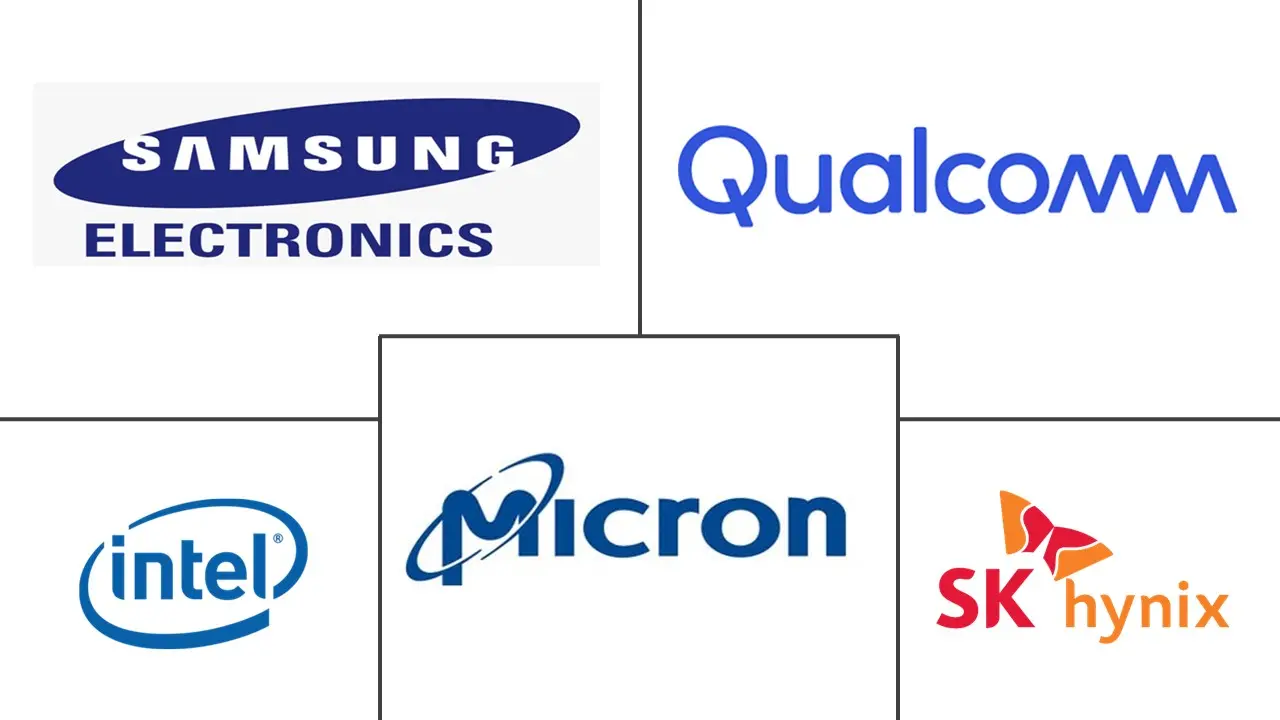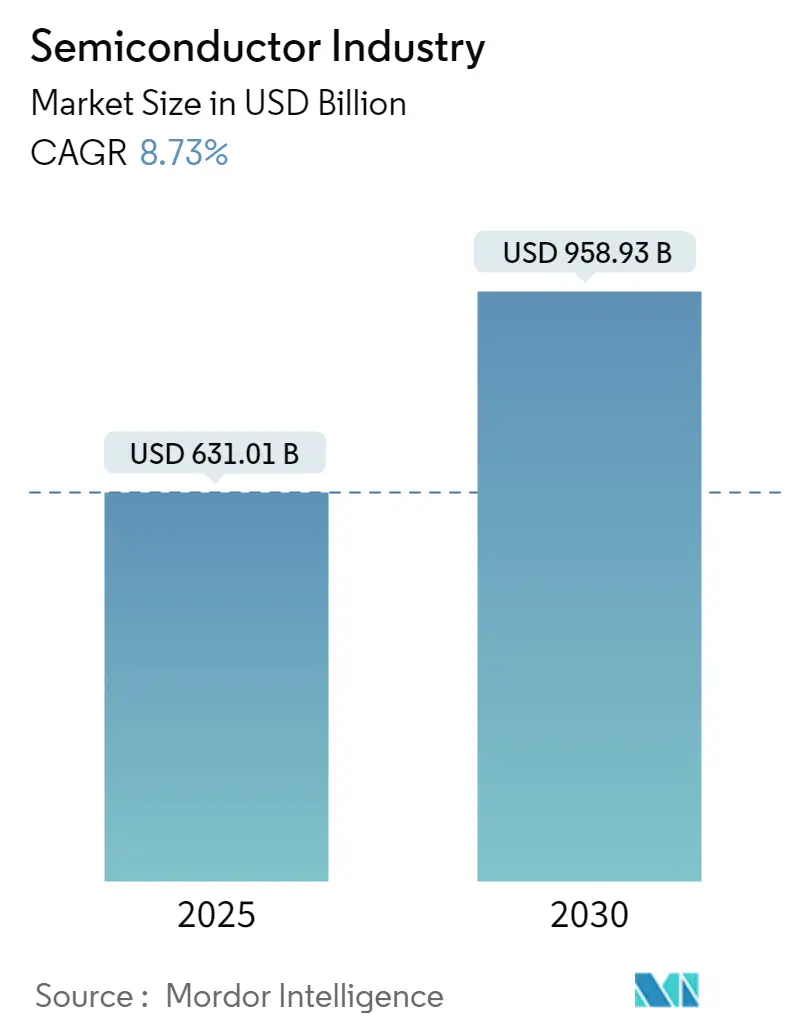
| Study Period | 2019 - 2030 |
| Market Size (2025) | USD 631.01 Billion |
| Market Size (2030) | USD 958.93 Billion |
| CAGR (2025 - 2030) | 8.73 % |
| Fastest Growing Market | Asia Pacific |
| Largest Market | Asia Pacific |
| Market Concentration | Low |
Major Players*Disclaimer: Major Players sorted in no particular order |
Semiconductor Industry Analysis
The Semiconductor Industry is expected to grow from USD 631.01 billion in 2025 to USD 958.93 billion by 2030, at a CAGR of 8.73% during the forecast period (2025-2030). In terms of shipment volume, the market is expected to grow from 1.40 trillion units in 2025 to 2.29 trillion units by 2030, at a CAGR of 10.32% during the forecast period (2025-2030).
- The semiconductor sector is experiencing a swift expansion as semiconductors are becoming the fundamental components of contemporary technology. Progress and breakthroughs in this industry directly influence all subsequent technologies.
- Semiconductor devices are electronic components that use semiconducting material as their foundation. This material produces transistors, diodes, and other fundamental functional units in integrated circuits (ICs). These devices are represented by their ability to neither conduct electricity well nor act as effective insulators. The benefits of semiconductor devices encompass their affordability, dependability, and compact size. Over the past few decades, the utilization of these devices in the production of diverse electronics has surged in popularity, and it is projected to continue gaining momentum in the forthcoming years.
- The expansion of smartphones, which is predicted to increase with population growth, is the key driving force for this market. Consumer electronics drive the industry due to increased demand for products such as tablets, laptops, smartphones, computers, and wearable gadgets. As semiconductor technology advances, new market areas, such as machine learning, are rapidly being integrated.
- The semiconductor equipment market is driven by the need for faster and more effective memory solutions. These semiconductors are becoming more sophisticated and can handle intensive memory operations. Overall, the market is seeing significant investments due to the increased reliance on IP solution providers.
- The semiconductor industry is projected to experience strong growth in the foreseeable future as it caters to the growing need for semiconductor materials in emerging technologies like artificial intelligence (AI), autonomous driving, the Internet of Things, and 5G. This growth is fueled by intense competition among key players and consistent investment in research and development (R&D). As a result, vendors are constantly driven to innovate and achieve a competitive advantage in the market.
- For example, Micron is a prominent company that plays a significant role in market analysis. By leveraging its industry-leading NAND technology, the company demonstrated its superiority by introducing the 232-layer node ahead of its competitors. In 2023, Micron expanded its manufacturing capacity for this advanced technology. Additionally, the company allocated substantial resources to develop innovative memory structures to transition smoothly to the next generation of semiconductor products.
- Furthermore, the ongoing Russia-Ukraine war has had a negative impact on the supply of specific raw materials utilized in semiconductor manufacturing, such as neon and palladium, which are critical inputs to particular stages of the manufacturing process. Consequently, the prices of these inputs have shot up, adding to the costs associated with the semiconductor manufacturing process. Direct supply chains with Russia and Ukraine, as well as supply chains that go through Russia, have all collapsed due to the start of the battle between Russia and Ukraine and the ensuing sanctions. As a result, the cost of various raw materials, energy, intermediate goods, and transportation services has dramatically increased. The ongoing war has created political and economic instability and declining consumer purchasing power.
Semiconductor Industry Trends
The Discrete Semiconductors Segment is Expected to Hold a Significant Share in the Market
- The discrete semiconductors segment includes devices like MOSFET, IGBT, bipolar transistors, thyristors, and rectifiers. The rising need for high-energy and power-efficient devices, the increasing prevalence of wireless and portable electronic products, and the increased use of these devices in the automotive industry due to the transition toward electrification are some of the key factors driving the segment's growth.
- One of the significant trends in discrete semiconductors is efficient power management. New system architectures improve AC-DC power adapters' efficiency while reducing their size and component count. New standards for power-over-ethernet (PoE) allow higher power transfer, enabling the development of new devices, like connected lighting.
- MOSFET has always played an essential part in the telecom sector, as switching power supplies are the most prevalent application for power MOSFETs, which are also commonly utilized for MOS RF power amplifiers, allowing mobile networks to move from analog to digital. According to Ericsson, 5G subscriptions are expected to increase drastically globally from 2019 to 2028, from over 12 million to over 4.5 billion subscriptions, respectively. Such reasons are expected to spur the demand for power semiconductors, increase the demand for MOSFETs, and lead to several breakthroughs in the telecom sector.
- The increasing demand for consumer electronic appliances like UPS, power conditioners, and air conditioners, which use discrete IGBT types for lower-current applications, is credited with driving the growth of the discrete IGBT market. Discrete IGBTs have been found to have the lowest power losses in consumer goods, which is expected to be a key factor influencing the segment's growth in the market.
- Furthermore, rectifiers are mainly used as AC-to-DC converters to generate DC power from an AC source. Almost all electronic equipment's power supplies contain rectifiers. Linear and switched-mode power supplies are two basic categories of AC/DC power supplies. In such a power supply, the rectifier will be connected in series with the transformer, followed by a smoothing filter and perhaps a voltage regulator. The market is expected to expand due to rising demand for rectifier diodes in various power sector applications and the miniaturization of conventional electronic equipment.
- Rectifiers are frequently used in electrical components to reference voltages, rectify voltages, change the size of signals, and isolate signals from their sources. Distinct rectifiers are utilized in electronic parts circuits to guard against the risks caused by the forced reversal of supply voltage. Rectifiers are essential components of DC power supplies and HVDC transmission systems. Therefore, the need for rectifiers is anticipated to be driven by factors such as rising government spending on power distribution infrastructure and increasing demand for smart grids.
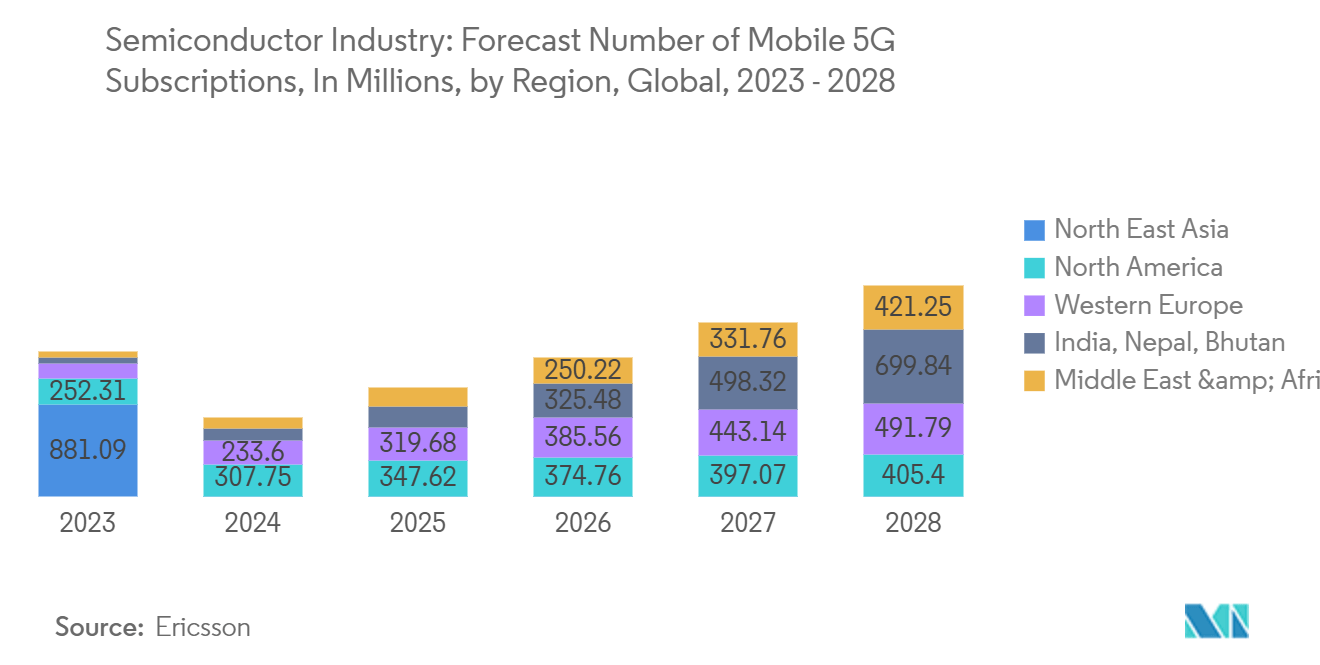
Asia-Pacific is Expected to Hold a Significant Share in the Market
- Asia-Pacific in the global market is anticipated to emerge as a prominent hub for equipment manufacturers to capitalize on the available prospects. This region has a substantial presence of semiconductor and electronic product manufacturers, predominantly in countries such as China, India, Taiwan, and Japan. Furthermore, numerous regions within Asia-Pacific are making substantial investments to augment their production capabilities, fueling the demand for semiconductor manufacturing equipment in the region.
- For instance, Taiwan plays a significant role in the semiconductor industry and substantially needs advancements in emerging technologies like 5G, IoT, AI, and big data. Additionally, the surge in investment toward new fab equipment to produce semiconductor goods is expected to drive market expansion in the coming years. Moreover, semiconductor manufacturing equipment manufacturers employ various tactics such as mergers, joint ventures, acquisitions, new product advancements, and regional expansion to enhance their market presence and meet evolving technological requirements.
- For instance, in October 2023, Tokyo Electron launched the Betelex 2700 PICP EX Plus, a cutting-edge chamber with superior plasma etching capabilities for 8.7th generation 1 glass substrates. This development was driven by the need to cater to the requirements of high-definition, high-value, and expansive displays in producing 8.7th-generation organic EL displays for IT products. Tokyo Electron successfully created the 8.7th generation plasma module PICP EX Plus to address these demands.
- In April 2023, Samsung Electronics Co., a significant foundry player, began package turnkey service for contract chip manufacturing. It aims to take on global player Taiwan Semiconductor Manufacturing Co. (TSMC) amid rapid growth in the artificial intelligence sector. Samsung focuses on the technology of packaging its flagship products, such as DRAMs, together with central processing units (CPUs) to attract Big Tech names, such as Alphabet Inc.’s Google LLC, which are developing their own AI semiconductors, as customers for the service.
- Moreover, semiconductor fabrication facilities in Asia-Pacific countries such as China, Singapore, and Korea are enhancing their activity. Numerous multinational memory manufacturers direct a large amount of investment into the Chinese semiconductor fabrication market. The country’s government initiatives, such as Made in China 2025, especially support these initiatives. Such initiatives are expected to draw more investments into the country, thus driving the market during the forecast period.
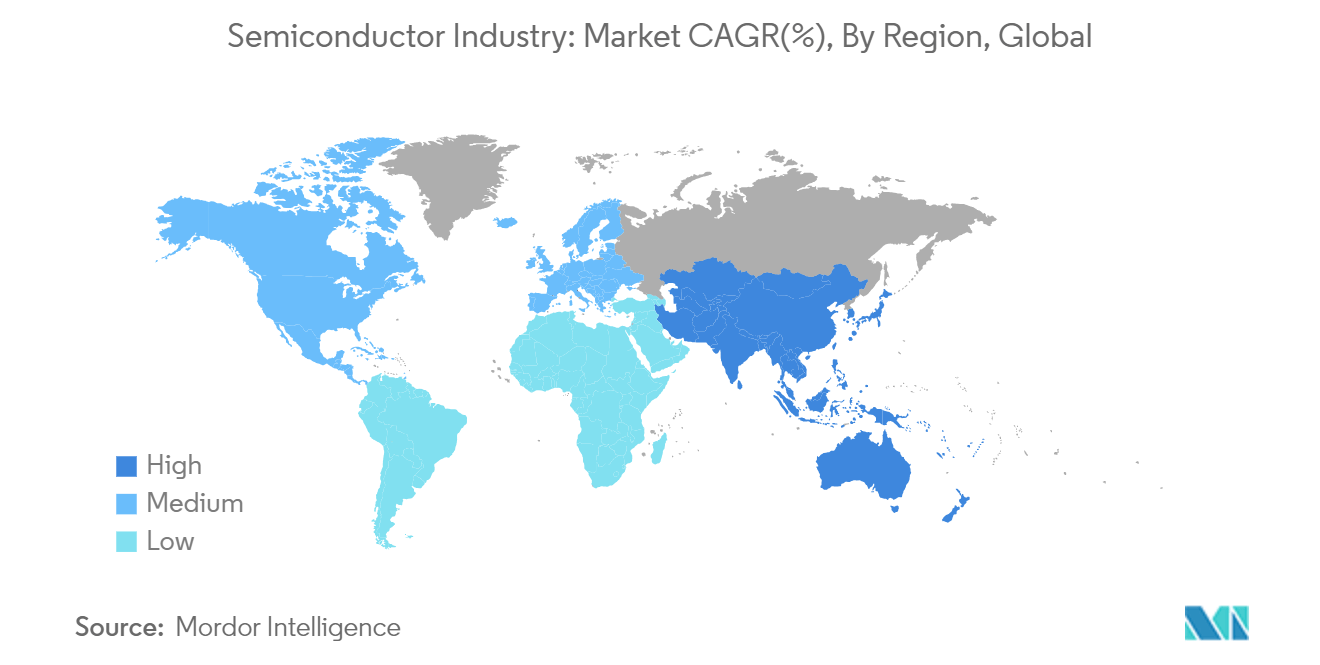
Semiconductor Industry Overview
- The semiconductor industry is fragmented, with the presence of major players like Intel Corporation, Samsung Electronics Co. Ltd, Qualcomm Incorporated, Micron Technology Inc., and SK Hynix Inc. Players in the market are adopting strategies such as partnerships and acquisitions to enhance their product offerings and gain sustainable competitive advantage.
- The growing Industrial 4.0 and the Industrial Internet of Things (IIoT) are at the heart of new technological approaches for the development, production, and management of the entire logistics chain, also known as smart factory automation. These are dominant trends in the industrial sector, with machinery and devices connected via the internet, which are expected to drive the market's growth in the coming years.
- For instance, in October 2023, SK Hynix conducted compatibility validation for the LPDDR5T after completing its development in January, with assistance from Qualcomm Technologies. The successful completion of this process confirms its compatibility with Snapdragon 8 Gen 3. The company intends to offer a 16 GB-capacity product comprising multiple individual LPDDR5T chips. These chips boast a remarkable data processing speed of 77 GB per second, enabling the processing of 15 full-HD movies in just one second.
- Growing industries, such as defense and aerospace, consumer electronics, healthcare, automotive, information and communication technology, and telecommunications, are driving the market's growth. Furthermore, in July 2022, The Karnataka Industries Department announced the new Aerospace and Defence Policy (2022–27), aiming for the State to be the preferred investment destination for aerospace and defense manufacturing. Under the new A&D policy, the State will develop five aerospace and defense hubs: Bengaluru, Belagavi, Mysuru, Tumakuru, and Chamarajanagara. The policy aims to attract investments worth INR 60,000 crore in the defense sector in the next five years, create over 70,000 employment opportunities, and develop the state as a manufacturing hub.
- According to India Business Unit Capgemini, in June 2022, India's manufacturing technology investments of about USD 5.5 billion-USD 6.5 billion were spent on IoT platforms, cloud, cybersecurity, data analytics, AI/ML, and AR/VR IoT platforms. Due to government policies and private sector investments, Indian manufacturing is witnessing a push to adopt digital technologies, aiming for a 25% contribution to the GDP by FY2026.
Semiconductor Industry Leaders
-
Intel Corporation
-
Samsung Electronics Co. Ltd
-
Qualcomm Incorporated
-
Micron Technology Inc.
-
SK Hynix Inc.
- *Disclaimer: Major Players sorted in no particular order
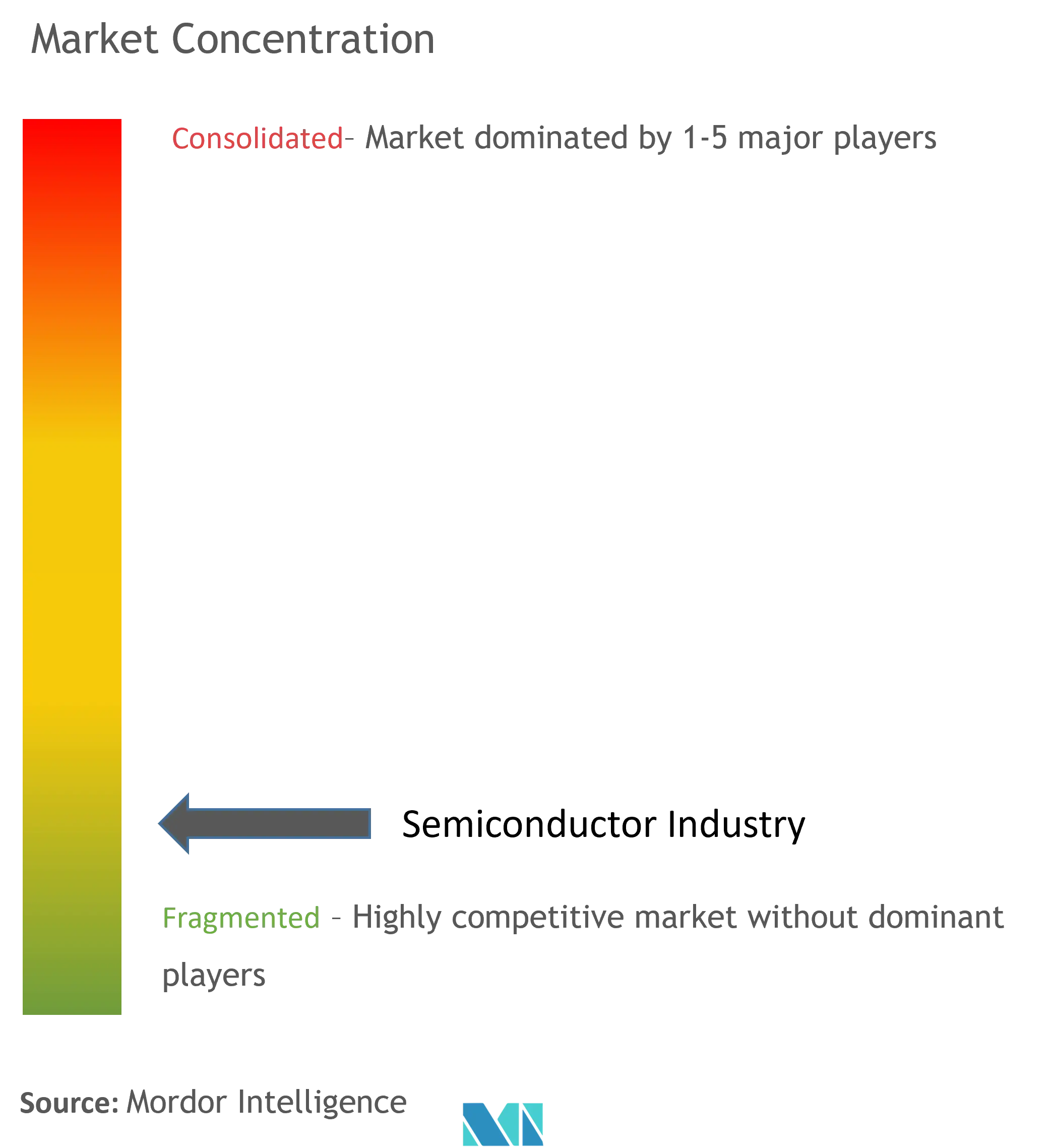
Semiconductor Industry News
- September 2024: Applied Materials India Private Limited, a subsidiary of Applied Materials Inc., launched a new initiative to foster innovation and education in semiconductor equipment. The initiative is designed to accelerate innovative solutions to the semiconductor equipment industry’s most demanding technical challenges. For the 2024 edition, Applied Materials India has selected three prestigious institutes, Indian Institute of Technology, Kharagpur; Indian Institute of Technology, Hyderabad; and Indian Institute of Technology, Gandhinagar, after assessing numerous proposals from top universities and institutes across India.
- June 2024: ROHM Co Ltd, a Japan-based power semiconductor device maker, launched its EcoSiC brand as a silicon carbide (SiC) product trademark. The EcoSiC logo is part of ROHM's ‘Power Eco Family’ branding concept, which aims to maximize electronic applications' efficiency and compactness while positively contributing to the environment.
- November 2023: Texas Instruments (TI) commenced the construction of its new 300-mm semiconductor wafer fabrication plant (or "fab") in Lehi, Utah. The company stated that this is the initial phase toward developing the new fab, LFAB2, which will be linked to TI's existing 300-mm wafer fab in Lehi. Upon completion, TI's two Utah fabs will be able to produce tens of millions of analog and embedded processing chips daily at full production. LFAB2 will be a valuable addition to TI's current 300-mm wafer fabs, which include LFAB1 (Lehi, Utah), DMOS6 (Dallas), and RFAB1 and RFAB2 (both in Richardson, Texas).
Semiconductor Industry Industry Segmentation
Semiconductors are essential technology enablers that power many advanced digital devices. The global semiconductor industry is set to continue its robust growth well into the next decade due to advancements in emerging technologies, such as autonomous driving, artificial intelligence (AI), 5G, and the Internet of Things (IoT), coupled with consistent spending on R&D and competition among prominent players.
The semiconductor industry is segmented by semiconductor devices (discrete semiconductors, optoelectronics, sensors, and integrated circuits), semiconductor equipment (front-end equipment and back-end equipment), semiconductors materials (fabrication and packaging), semiconductor foundry market, outsourced semiconductor assembly test services (OSAT) market, and geography (North America, Europe, Asia Pacific, Latin America, and Middle East and Africa). The market sizes and forecasts are provided in terms of value (USD) for all the above segments.
| By Semiconductor Devices | Discrete Semiconductors |
| Optoelectronics | |
| Sensors | |
| Integrated Circuits | |
| By Semiconductor Equipment | Front-end Equipment |
| Back-end Equipment | |
| By Semiconductors Materials | Fabrication |
| Pacakging | |
| By Geography*** | North America |
| Europe | |
| Asia | |
| Australia and New Zealand | |
| Latin America | |
| Middle East and Africa |
Semiconductor Industry Research FAQs
How big is the Semiconductor Industry?
The Semiconductor Industry size is expected to reach USD 631.01 billion in 2025 and grow at a CAGR of 8.73% to reach USD 958.93 billion by 2030.
What is the current Semiconductor Industry size?
In 2025, the Semiconductor Industry size is expected to reach USD 631.01 billion.
Who are the key players in Semiconductor Industry?
Intel Corporation, Samsung Electronics Co. Ltd, Qualcomm Incorporated, Micron Technology Inc. and SK Hynix Inc. are the major companies operating in the Semiconductor Industry.
Which is the fastest growing region in Semiconductor Industry?
Asia Pacific is estimated to grow at the highest CAGR over the forecast period (2025-2030).
Which region has the biggest share in Semiconductor Industry?
In 2025, the Asia Pacific accounts for the largest market share in Semiconductor Industry.
What years does this Semiconductor Industry cover, and what was the market size in 2024?
In 2024, the Semiconductor Industry size was estimated at USD 575.92 billion. The report covers the Semiconductor Industry historical market size for years: 2019, 2020, 2021, 2022, 2023 and 2024. The report also forecasts the Semiconductor Industry size for years: 2025, 2026, 2027, 2028, 2029 and 2030.
Our Best Selling Reports
Semiconductor Industry Industry Report
The global semiconductor market is on a significant growth trajectory, fueled by rising demand in sectors like network and communication, data processing, automotive, and consumer electronics. The Asia Pacific region stands out, thanks to its robust electronics industry and rapid urbanization, with government initiatives worldwide boosting this growth through investments and supportive policies. Challenges like supply chain disruptions and the need for technological advancements remain, yet the industry is set for expansion, driven by advanced technologies such as artificial intelligence and the Internet of Things. The increasing reliance on semiconductors in sectors like healthcare and automotive further underscores their critical role in the digital economy. Statistics for the Global Semiconductor market share, size and revenue growth rate, created by Mordor Intelligence™ Industry Reports. Global Semiconductor analysis includes a market forecast outlook and historical overview. Get a sample of this industry analysis as a free report PDF download.

